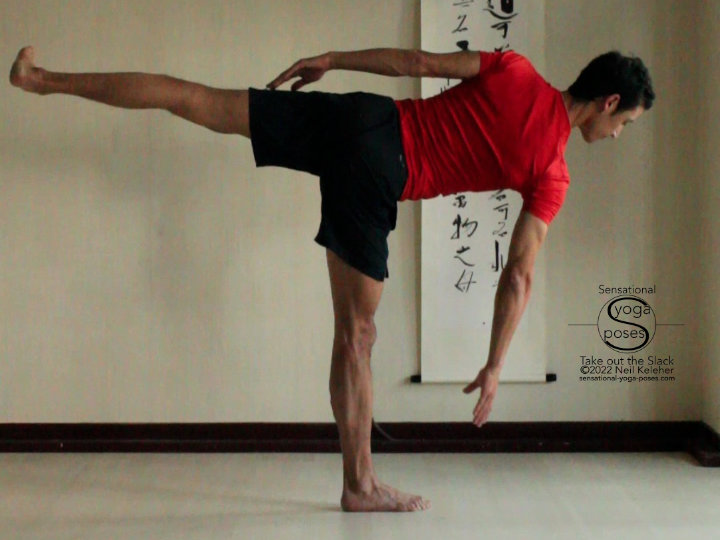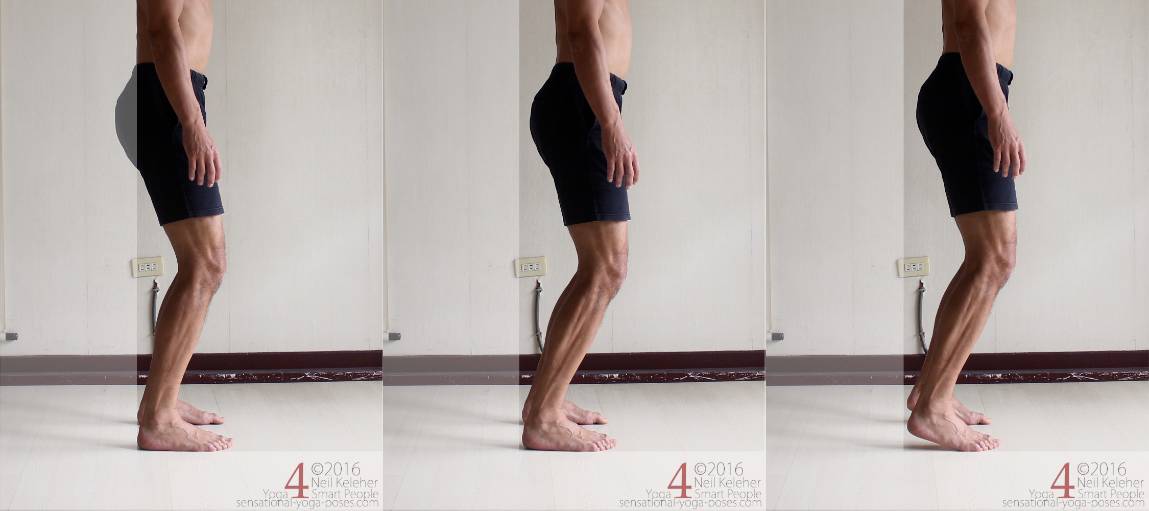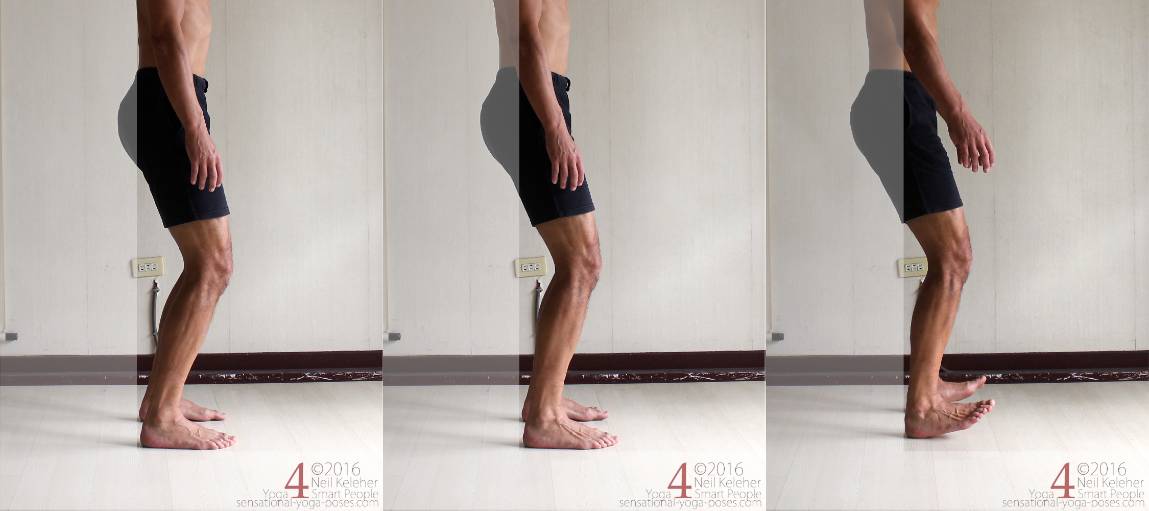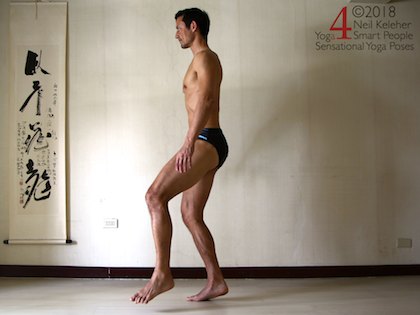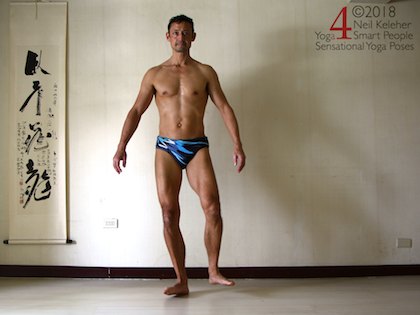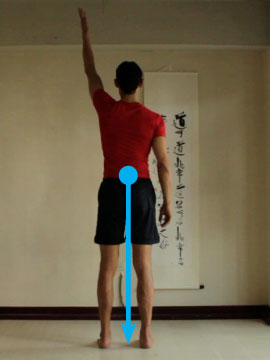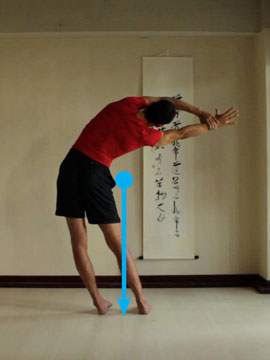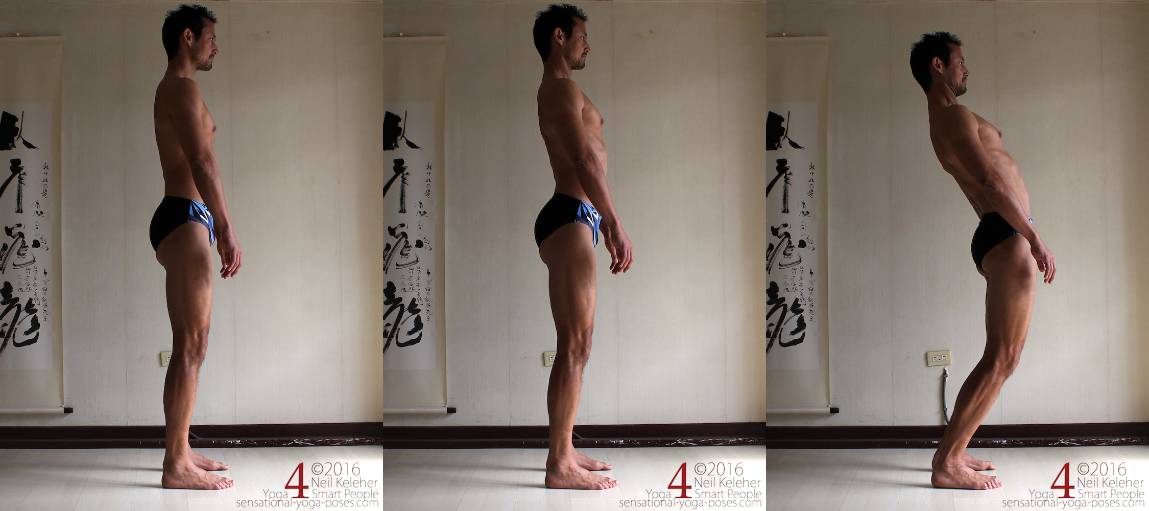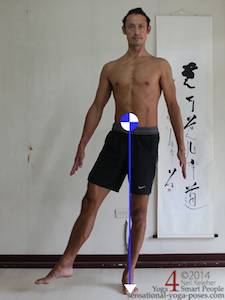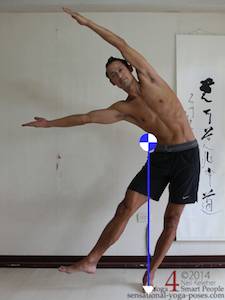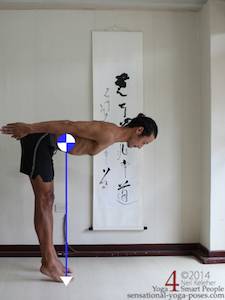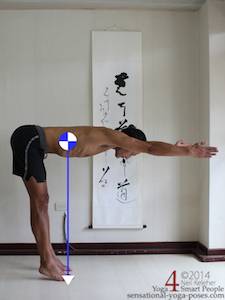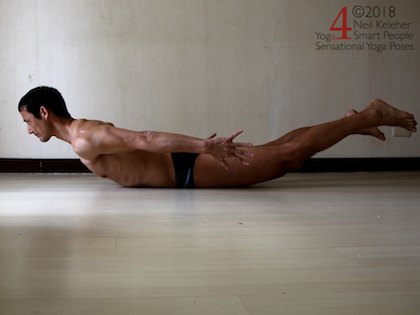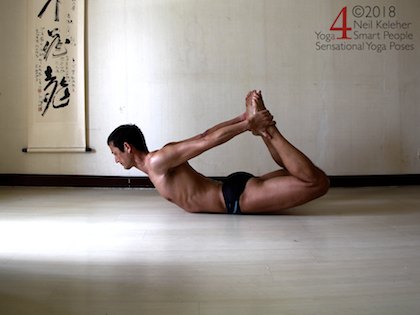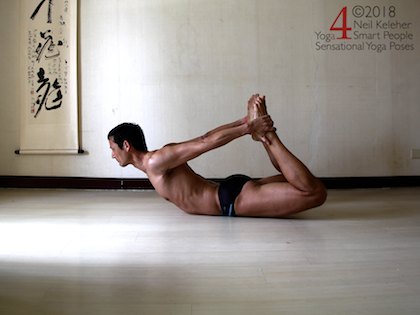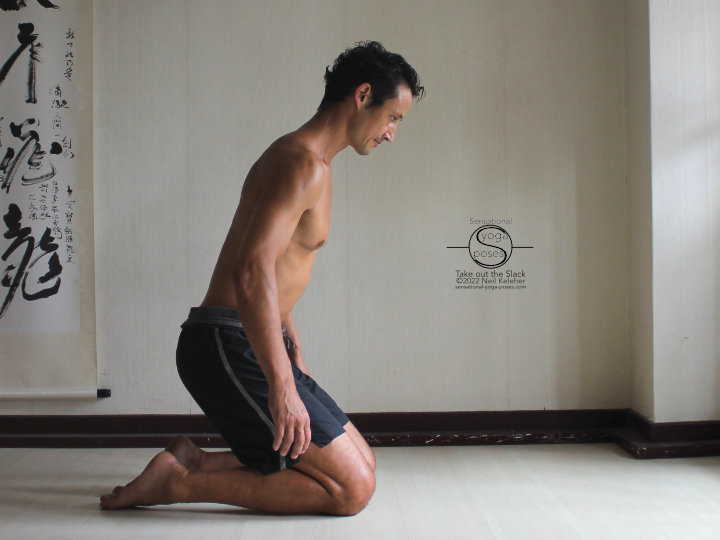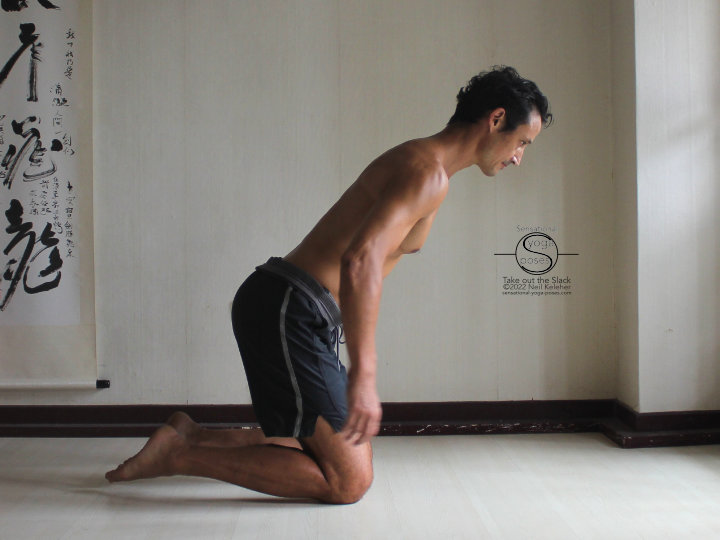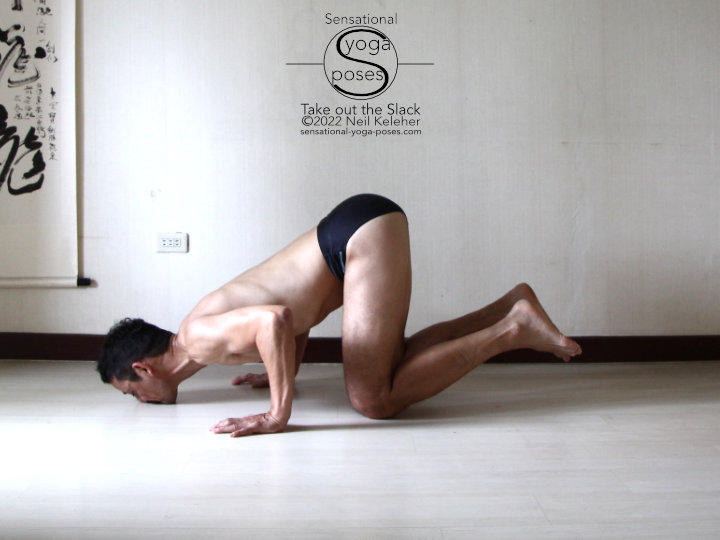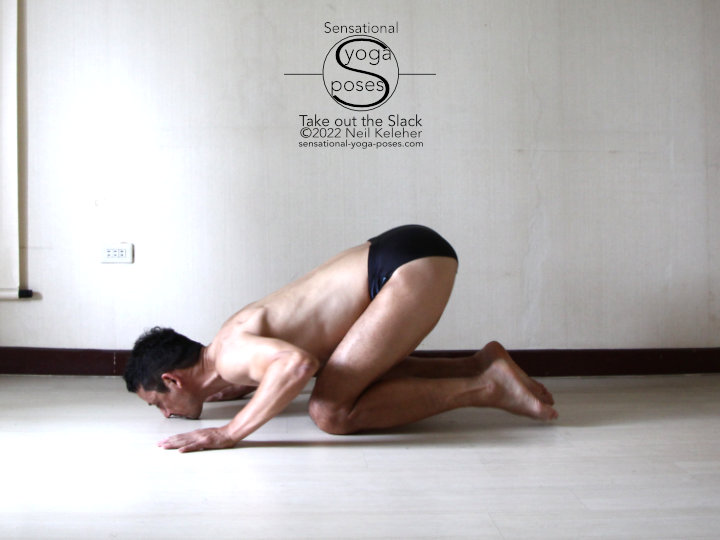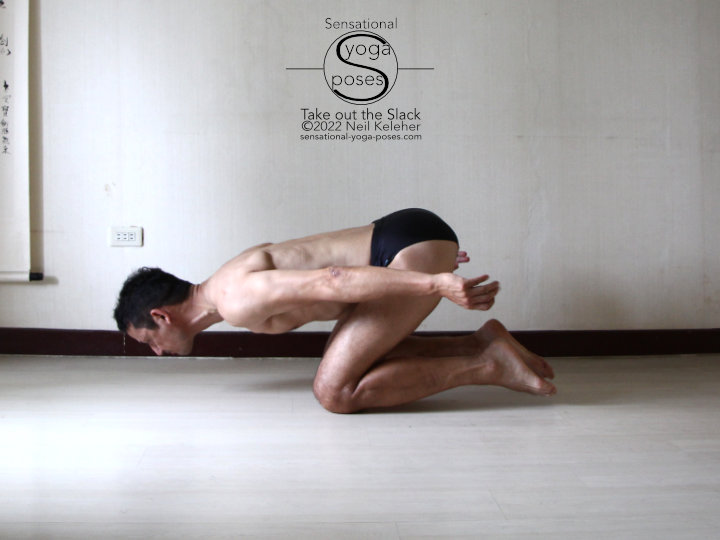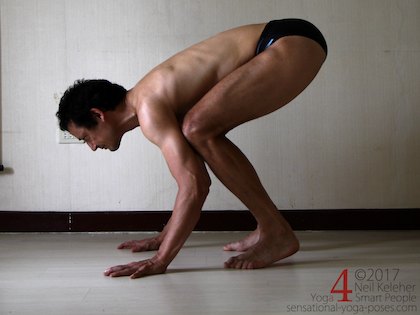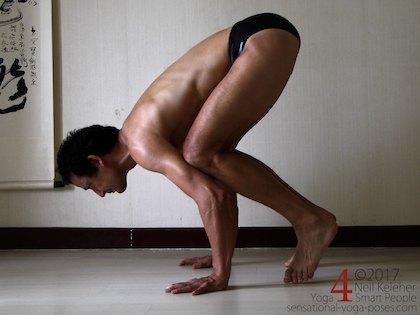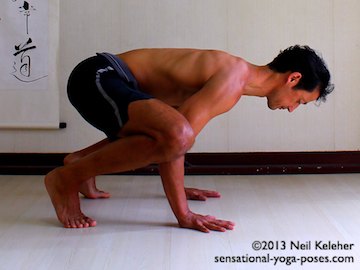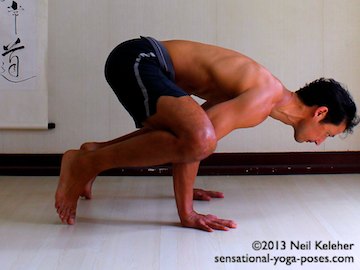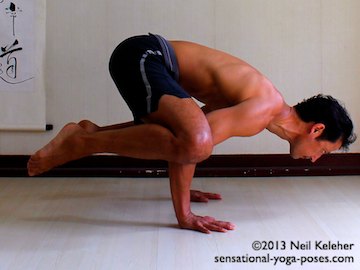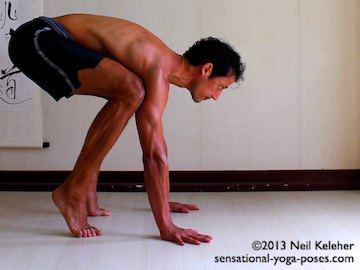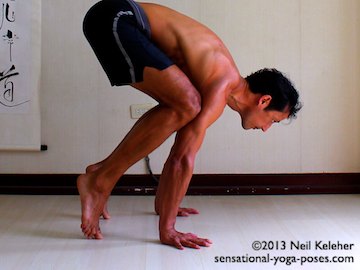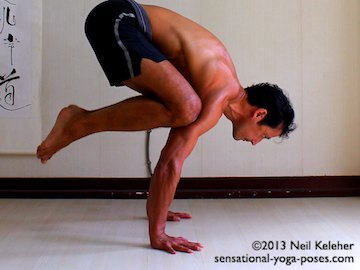You can also read the Chinese (Traditional Characters) translation of this webpage: Feeling your center of Gravity in Chinese (Traditional).
Using Pressure to Feel Where Your Center of Gravity Is
When standing, we can use our feet as pressure sensors. The weight of our body presses through the bones of our feet which compresses the skin of our feet.
The greater the pressure, the greater the sensation.
The trick to feeling where our center of gravity is with respect to our feet is noticing the point of greatest pressure. That's the point (or line) over which our center of gravity is positioned.
How to weigh a truck
You can figure out the weight of a car or truck by putting the front wheels on a scale, noting the weight, and then putting the back wheels on the same scale.
If the weight is even at the front and back wheels (if both measurements show the same weight) then the vehicle's center of gravity is midway between the front wheels and the back.
If the weight is different at each set of wheels, then the difference in weight can be used to calculate where exactly the center of gravity is with respect to the front and back wheels.
We can use the same idea to position our center of gravity evenly between both feet.
Learning to center your weight between both feet
If we feel our feet and notice that our weight is even on both feet then that means our center of gravity is above a point midway between our feet.
To work towards the required sensitivity, a simple exercise is to shift your body to one side, so that your weight is entirely on that foot, then shift back to center. Repeat a few times. Then try it while shifting weight onto the other foot.
Do this slowly and smoothly so that you can feel the increase in pressure as you shift weight to one foot, and the decrease in pressure as you shift weight away from the other foot.
Once you have a feel for these changes in pressure, you can then look for the position in which pressure is even in both feet. This indicates that your weight is centered between them.
Shifting weight to one foot
The same basic exercise can be used to shift weight to one foot.
The idea here is to shift weight to one foot to the point that you feel the other leg relax completely. That indicates that that leg is no longer supporting any of your body weight. If your standing foot and leg is braced sufficiently, you can then lift the unweighted leg without further shifting of your upper body. This is provided you lift the leg straight up, and not out to the side.
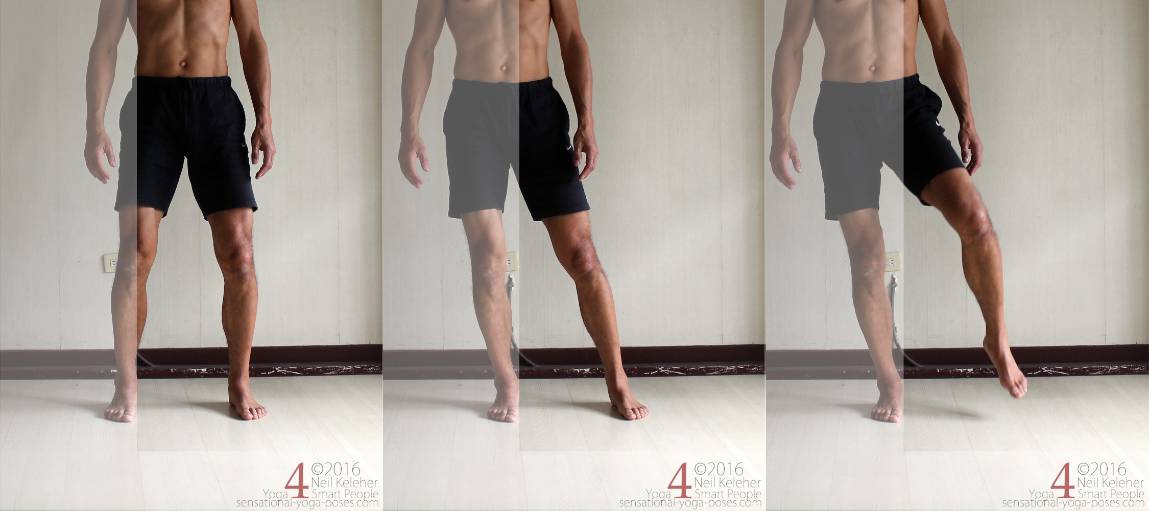
Note, when lifting the unweighted leg, you need only lift it high enough that your foot is clear off of the floor.
Shifting your weight forwards and back
You can use a similar exercise to feel your center of gravity as you shift it forwards and back.
The first part of this exercise is to get used to shifting your weight forwards and back.
- For this you can practice shifting forwards so that your weight is over your forefeet and toes.
- Then shift back so that your weight is on the back edge of both heels.
After repeating a few times, try to center your weight between your heels and forefeet. To fine tune your positioning, try moving slightly forwards and back till you can feel the position where weight is even on both your forefeet and heels.
Balancing on your forefeet or heels
Once you get used to feeling your center of gravity as you shift it forwards and backwards, you can also work at holding it either forwards over your forefeet, or rearwards, over your heels.
In either case, it's important to stop your body as soon as you feel that your weight is shifted over your heels or your forefeet!
To balance on your forefeet and toes, shift your weight forwards so that your forefeet and toes press down with maximum pressure. Your heels should only lightly touch the floor. You can then lift them (or they may lift by themselves.)
For balancing on your heels with forefeet lifted, shift your weight back so that the back edge of your heels press down with maximum possible pressure. You may find that your forefeet lift automatically.
You can then try these same exercises while standing on one foot!
Shifting Your Center of Gravity Relative to Your Body
In the above weight shifting examples, we were mainly shifting our body relative to our foundation. Those exercises are good for getting a generally feel for our center by using our foundation.
It's also possible to shift our center of gravity relative to our body.
To this end, it helps to understand that each part of the body has it's own center of gravity.
Those parts are: the arms (the forearms, the upper arms), the head, the ribcage, the pelvis, the legs (the thighs, the calves and feet).
The position of the body's overall center of gravity relative to the body depends on the position of all of these elements relative to each other.
The position of our center of gravity within our body is affected by our posture.
Moving one part of the body relative to another shifts the body's center of gravity. While we can move an arm, both arms, a leg or both legs to shift our center relative to our body, we can also simply bend at our hips or our spine to shift our center relative to our body.
I'll use Center and CG interchangeably with Center of Gravity.
Changing our posture to shift our center of gravity
To start with, it can help to understand that standing upright with our hands by our sides, our center of gravity is generally positioned somewhere within our pelvis.
However, if we push our hips to the side while bending our body in the opposite direction, then our center of gravity shifts sideways relative to our pelvis.
The blue circle shows the approximate position of my
Center of Gravity
If we push our hips straight back (from the upright standing position) while bending forwards, then we shift our center of gravity forwards, relative to our pelvis.
If we push our hips forwards while at the same time bending backwards (again, from an upright position) then we shift our center of gravity to a position behind the hips.
Some examples of how changing our posture shifts our center of gravity relative to our body
If we stand upright with one foot lifted, then our center of gravity is over the foot we are standing on. (Below left.)
Pushing our hips left while keeping our center of gravity over our foot, our center of gravity ends up to the side of our pelvis instead of being centered within it. (Above right.)
Bending forwards at the hips while balancing on our forefeet, with our arms reaching back, our center of gravity is over our forefeet. (Below left.)
Moving our arms forwards while staying balanced on our forefeet, then our center of gravity shifts closer to our ribcage. (Above right.)
Staying balanced while changing your posture
If you feel your feet and focus on keeping the weight on both feet the same, even as you move your hips and ribcage in different directions, then your center of gravity stays in the same vertical location (directly over your feet) even as you move your upper body around.
That means that you can move your body while keeping your center of gravity over your foundation.
In plainer terms, this means that you can learn to move your body while staying balanced!
Moving into a standing side bend, you can start with weight even on both feet. Then, as you push your hips to the left while bending your torso to the right, you can work at keeping weight even on both feet.
This means that you are keeping your center of gravity centered between both feet. You can confirm this if you can feel both of your feet pressing down with equal pressure.
Note that you could start with your weight centered over one foot. You could then work at keeping your center over that foot while pushing your hips in one direction and bending your spine in the other.
Feeling where your center of gravity is while lying prone
As mentioned, our head, ribcage, pelvis, arms and legs each have their own CG.
The sum of all of these centers adds up to one center of gravity that is positioned somewhere in the region of our pelvis (assuming we are standing upright, with your arms by your side.)
One way to feel where this center is located vertically within our body is to lay down on our belly and lift our head, chest and legs so that we are doing locust pose.
The part of your pelvis that presses down the most is the region of your pelvis where your center of gravity is located at.
If you reach your arms forwards while staying lifted, you'll tip forwards a little (or a lot) because you have shifted your center of gravity forwards. Probably you'll find that your lower belly becomes your balance point.
Another prone pose where you can feel your center relative to your pelvis is bow pose, shown below. By increasing the spinal back bend, or by decreasing the knee bend (try pulling the feet back, away from you) and/or by looking more forwards, or even up, the change in shape at the knees and/or spine can cause your center to shift rearwards.
Your body will tip back as a result.
Using any point of connection to feel where your center of gravity is
As demonstrated above with locust and bow pose, we can use other parts of our body to feel where our center is.
If we learn to feel where our center of gravity is via our feet, it's relatively simple to learn to use other parts of our body as pressure sensors.
As an example, if we want to balance in crow pose (and other arm balancing yoga poses), we can learn to use our hands as pressure sensors.
To prepare for crow pose, and to get used to the idea of using other parts of our body as pressure sensors, we can practice shifting our weight while kneeling.
In this case you'll be learning to use your knees (and the tops of your feet) as pressure sensors.
Using your knees as pressure sensors
(Use padding under your knees if you find this uncomfortable!)
Starting with your weight back, you should be able to feel your feet pressing into the floor. Lifting your hips higher if necessary, shift your body forwards so that you feel your knees pressing down. Shift far enough forwards that your feet only lightly touch the floor. You should then be able to lift your feet.
(If not, then try shifting your body further forwards relative to your knees!)
Shift back and repeat a few times.
Shifting your center back over your knees
Another exercise you can use to get used to feeling your center while kneeling is to go on all fours. Bend your elbows so that you can put your face (or chin) on the floor. (Again, use a folder blanket, pillow or other cushioning if necessary!) Using your hands to help, move your hips back to get your center of gravity over your knees. (You may have to position your face closer to your knees!).
When you feel your weight over your knees, or at least most of it, you may find that by reaching your arms back you can lift your chin off of the floor.
Shifting your center over your hands for crow pose
For crow pose, you can rest your knees on the backs of your upper arms. Shift your hips forwards so that your knees press into your arms. At the same time, feel your weight shifting towards your your hands.
This can be scary, so to make it less scary, practice shifting forwards and backwards, increasing the amount you shift forwards gradually. You can then get used to using your hands, and fingers, to feel your center of gravity.
Once you can feel when your center is over your hands (by noticing when your hands and elbows have maximum pressure and your feet no pressure), you can then lift your feet without having to further shift your body forwards, whether you are doing crow pose with elbows bent or straight.
In the top picture my hips, and my center of gravity, are behind my hands. In the bottom two pictures, my center of gravity is over my hands meaning that I can lift my feet.
If doing crow pose with straight elbows, you may have to pinch your upper arms by pressing your knees inwards. But the idea is the same. When you can feel your center is over your hands, you can lift your feet.
Published: 2011 07 21
Updated: 2022 07 21
